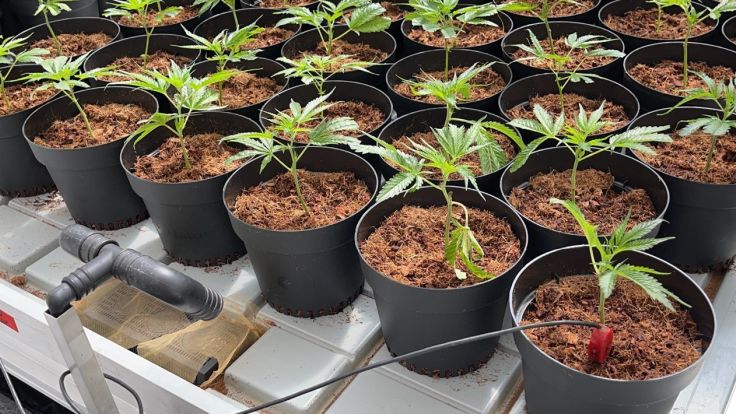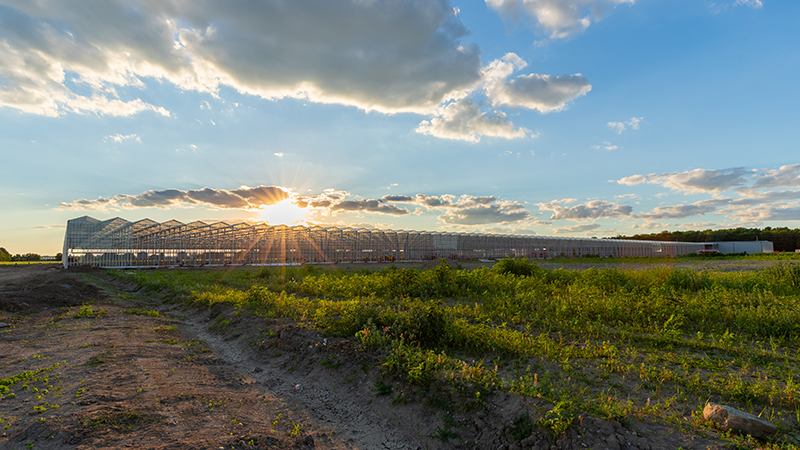Mind Your Water When Managing Greenhouse Crops

Photo: Resource Innovation Institute
Improving resource efficiency in controlled-environment agriculture (CEA) systems is essential to ensure sustainable food and crop production and preserve the planet’s precious resources. In its upcoming “CEA Energy & Water Benchmarking Report” to be released in June, Resource Innovation Institute (RII) found that greenhouse operators growing leafy greens, for example, are using drastically varying amounts of water to produce their crops. The most efficient greenhouse operators can grow crops using less than 3 gallons per pound produced (gal/lb.), while others are using more than 20 gal/lb.
With water scarcity becoming an increasingly critical issue, greenhouse operators must take steps to reduce both their water use and water waste regardless of the crops they grow. As resource costs continue to climb, there also is an economic incentive for CEA producers to adopt the most efficient systems and practices to maintain profitability.
Here are some best water-efficiency tips and practices to help your business mind its water usage.
Knowing Is the First Step
The first step greenhouse owners (or any CEA facility operators) need to take when trying to optimize their water efficiency is to track their current water use. While it may seem obvious, many operations only track the entire water volume that their facility uses through their utility’s water meter or sewer discharge meter. This setup leaves growers unaware of where the water is being used most, and where it is potentially being wasted.
To become better water stewards, CEA operators must know how much of their water is going towards irrigation, climate control, or processing (the latter includes water used for spraying pesticides, sanitation, rinsing vegetables, or floating plants down a flume for further processing).
A well-maintained operation may be missing out on resource-saving efficiencies by only monitoring the quantity of water it uses, as water quality determines water quantity. Put differently, water quality monitoring determines what use is suitable and how long that water can be used before needing to be replaced.
It is crucial to collect data to identify when and where water is wasted for greenhouses using evaporative pad-and-fan cooling. Evaporative cooling pads can be poorly adjusted and spring leaks that easily go unnoticed by greenhouse workers, which can in turn lead to significant amounts of water being dumped on the greenhouse floor. This type of water leakage is also common for hydronic heating systems that rely on boilers.
Location alone may necessitate higher water usage. For example, CEA operations located near the coast or those using groundwater with high total dissolved salts (including ions of N, P, K, Mg, and Na) might find themselves watering their crops grown in potted media more frequently to avoid a scenario where the media dries out. Overly dry media could lead to root death due to concentrated leftover salts. High sodium levels will lead to Ca, Mg, or K deficiencies. To be specific, operations with high sodium or high total dissolved salts may aim for a 20% to 40% leachate rate, as opposed to a more typical 10% to 20% leachate rate. (Leachate rate measures the amount of water that drains from the bottom of the pot.)
Cut Back
Only by measuring the water coming into your facility, analyzing where it is being used most heavily (and potentially wastefully), and identifying how much is going to waste will greenhouse operators start to be able to identify resource-efficient processes and system improvements.
One easy place to start is to evaluate watering methods. Experts agree that hand-watering pots is the least efficient irrigation strategy.
Hand-watering often comes with a high flow rate. Because of that, “little inaccuracies can be very additive” when watering multiple potted crops, says RII member Tera Lewandowski, who also is a senior research scientist with Hawthorne.
Drip emitters are a much more sustainable option compared to overhead watering, she notes.
“When we have drip emitters and we’re doing low-and-slow irrigation, even if you mess up by a couple of minutes for some reason, your total water volume delivered is not anywhere near what it’s going to be in that overhead method.” Lewandowski says.
Operators can sometimes minimize their watering by saturating the media with water once per day. Depending on the potting media’s exact composition and its water-holding capacity, saturating the media once can reduce the total volume of water applied compared to applying multiple amounts of smaller doses.
“We can let that pot dry all day, and that plant does not get to an unhealthy level of wilt,” Lewandowski shares. (Note: Not all crops and media will respond as well to drench irrigation compared to drip irrigation.)
Adjusting container sizes, shapes, and dimensions also can help growers find the right balance between drainage needs and water efficiency – the same volume of potting media will hold more water if it’s in a low, squat container than if it’s in a taller container of the same volume. With higher water-holding capacity, however, comes the risk of anaerobic conditions that could lead to substrate disease such as root rot. Growers will need to monitor their substrates to ensure they are not over-saturating their media.
Lewandowski advises growers to aim to keep their volumetric water content (VWC) between 50% to 70%, depending on the specific crop. A common mistake she sees cultivators make is cutting their watering down too much. Depending on the substrate type and the crop being grown, if a cultivator were to maintain a low VWC for extended periods, the crop might struggle to acquire that water, expending energy on resource acquisition rather than on its development (whether yield or secondary metabolite production). That said, this dry-down is sometimes done by growers after transplanting to force the plants to hasten root growth to find more water.
Optimizing Hydroponic Systems
In hydroponic systems, including drip-irrigated rockwool cultivation, water is critical as it is the only way plants get access to nutrients. There are a variety of factors that can exacerbate water waste in these systems, including poor climate and water management techniques.
For example, if the irrigation event flow rate is too high, excess runoff and channeling can cause a larger volume of nutrient solution to pass through the substrate than is necessary, increasing the amount of water sent to waste, according to RII member Marielle Taft, Senior Crop Specialist with Grodan.
Another mistake she sees in hydroponic operations is drip stakes driven too deeply into the media.
“You might have the correct flow rate, and you might be applying the right volumes in any given irrigation event, but if your drip stakes are inserted too far into the media, the water could simply bypass the top of the substrate,” Taft says. “That upper portion will become unsuitable for root colonization and unusable to the plants because it’s entirely dry.”
Growers who then believe their media is dried out are likely to increase their watering (and, consequently, the amount of water that is wasted). Proper drip stake depth varies based on the manufacturer and growing medium used. Taft advises operators to check with their drip stake manufacturer on proper placement. With many of the popular drip stake brands, the deeper you place the stake, the dryer the surface will remain, whereas a more shallow placement will lead to a wetter substrate surface.
Hydroponic systems can maximize water efficiency by closing the loop–meaning recapturing, recycling, and reusing the nutrient solution. This is largely because inorganic media such as stone wool (aka rockwool) does not contribute excess tannins, cations, or inherent biological contaminants to the leachate water.
While it is more difficult to create a water circularity system with organically derived media (like soil or coco), it is possible to build a system to recycle and reuse water several times before the solution needs to be dumped and replaced.
A water circularity system must be designed with both efficiency and your production practices in mind. Operators using pre-blended soluble powders or pre-blended liquid nutrients typically cannot adjust the individual elemental PPM contributions of their recaptured fraction as nimbly and precisely as those using individualized raw fertilizer derivatives, Taft explains.
That said, if a facility is going to have a hard time sending out samples for quantitative laboratory analyses on a regular basis, or lacks the technical confidence to make on-the-fly adjustments, there are many other systems available to them for drain-water recirculation. This infrastructure might feature components such as UV, ozone, electrolysis, and/or other chemical treatments to sterilize organic pollutants combined with selective membrane filtration, drain water re-introduction tanks, or even reverse osmosis units to strip the solution of ions after multiple uses. Typically, RO systems are avoided for drain-water filtration because of their inefficient ratio of brine water (waste) to permeate (pure water), but some facilities find creative solutions for the brine fraction such as on-site water holding for fire protection, or surface irrigation for salinity-tolerant landscaping plants. And ultimately, any amount of water that is diverted from waste drains is an improvement.
Keep a Clean House
An often overlooked aspect of water efficiency practices is to stay on top of mineral and biofilm buildup in irrigation lines, which can reduce the inside diameter of the irrigation lines and lead to restricted water flow and uneven water distribution. The impacts of this buildup can potentially damage or stunt plant growth, which in turn compels growers to avoid recirculating that water.
For example, biofilms and mineral buildup coating the interior of irrigation delivery pipes and tubing can harbor plant pathogens and cause clogs that prevent water and fertilizer from reaching the crops. This can lead to reduced crop yields, loss of crops due to desiccation, and outbreaks of pathogenic organisms in the root zone and the drain water solution.
Taft says the post-harvest reset is the perfect time for operators to inspect and maintain irrigation systems.
“Every time you harvest a crop, you have this crucial window of opportunity to use very effective sanitizing agents to eradicate biofilms and mineral occlusion and halt the proliferation of plant pathogens,” Taft says. “At their ideal concentration for cleaning, they would harm or kill plants, so take advantage of every opportunity to clean the irrigation system when the greenhouse is empty before repopulating it with plants.”
An industry best practice, Taft notes, is to “use some kind of acid, most commonly it’s sulfuric acid, to dissolve and strip the mineral layer first.” This will expose the biofilm layer to the subsequent disinfectant or oxidative agent that gets injected. “All too often, people don’t realize there’s usually a mineral salt layer that’s encrusting the biofilm, protecting it in a sense. By removing the layer of salt precipitate first, you can ensure the biofilm is fully exposed to the oxidizer or disinfectant you use, ensuring the solution can make adequate contact with the biological layer.”
Building a CEA facility that maximizes productivity and resource efficiency is a tall order no matter your operation’s size. With the right long-term mindset, an understanding of your operation’s potential, and access to industry-leading information sources (like RII’s upcoming Energy & Water Benchmarking report), CEA operators can increase both their resource efficiency and their bottom lines.
Want to learn more about water efficiency for CEA? Check out RII’s Best Practices Guides and other published and peer-reviewed resources covering topics such as facility design and construction, lighting, HVAC at catalog.resourceinnovation.org, and look for an upcoming water benchmarking report to be released in June. You can also learn more insights from RII here.









